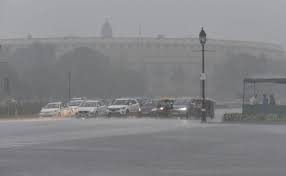Rains lash Delhi, traffic moves at snail's pace

New Delhi: Widespread rains lashed the national capital on Tuesday, leading to heavy waterlogging that threw traffic out of gear in many parts of the city.
Vehicles moved bumper-to-bumper on DND flyover, Akshardham road and the ITO crossing.
Traffic bottlenecks were also witnessed on stretches of Rohtak Road, near Tis Hazari court, from Khyber Pass towards Model Town.
A tree fell on the stretch between the Maharani Bagh and Ashram leading to traffic chaos.
By and large, rains covered the entire city, the weather department said.
The Safdarjung Observatory, which provides official figures for the city, recorded 22.2 mm rainfall. The weather stations at Palam, Lodhi Road, Ridge and Ayanagar gauged 9.6, 24.3, 32.8 and 7.9 mm precipitation.
More rains are predicted on Wednesday.
Thereafter, the axis of monsoon trough will move towards south of Delhi. Patchy rains at isolated places will continue till August 11-12, Mahesh Palawat of Skymet Weather said.
On July 22, the Safdarjung observatory recorded 50.2 mm rainfall, the heaviest this monsoon. The weather station at Palam gauged 61 mm precipitation on July 18.
More than 65 mm of precipitation is considered heavy rain. Palawat said a combination of weather systems leads to heavy showers.
"Heavy rains take place when a western disturbance, cyclonic circulation, easterly winds from the Bay of Bengal or southwesterly winds from the Arabian Sea combine with the monsoon trough," he explained.
On Tuesday, the city recorded a high of 30 degrees Celsius and a low of 26.7 degrees Celsius.
Delhi has recorded just 36 mm of rain against the 30-year average of 69.1 mm -- a shortfall of around 48 per cent -- in August so far.
The city gauged 199.2 mm rains in July, which is five per cent less than the long-term average of 210.6 mm.
Overall, it has received 224.2 mm of precipitation against the long-term average of 337 mm since June 1, when the monsoon season starts, a deficiency of around 33 per cent, IMD data showed.















































